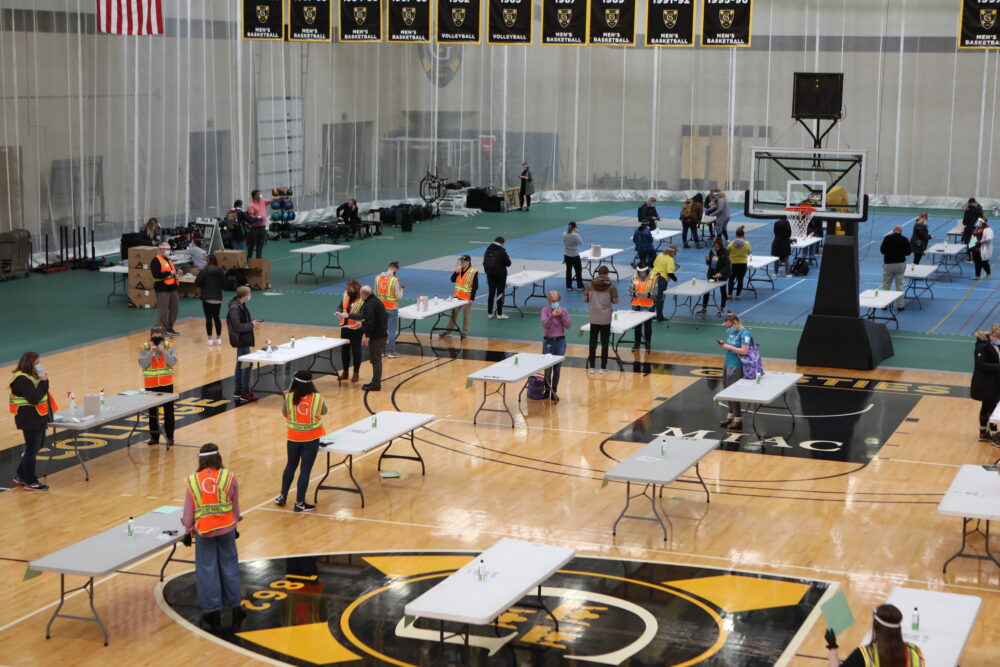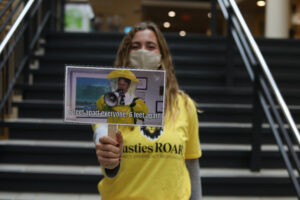
One of three COVID testing events on campus in 2020. The combined positive rate of the three events was 1.23 percent.
by Emma Nelson ’22
When Gustavus Adolphus College students packed up to leave campus on March 13, 2020, they faced an uncertain future. Only a week after the first confirmed case of COVID-19 in Minnesota, Gustavus joined institutions across the state and country in the transition to virtual learning, with no clear path forward.
“The plan was that students would go away for a couple weeks and then come back to finish the school year,” according to associate vice president for marketing and communication Barb Larson Taylor ‘93, who was tapped to lead the College’s COVID-19 response in the spring. “But as we approached the end of the school year, it became clear that COVID wasn’t going away, it was going to be here for fall. And the question was: how are we going to do this?”
The President’s Cabinet and the COVID-19 Response Leadership Team oversaw the creation of 12 action groups in June, each addressing a different component of the College’s pandemic response. More than 125 students, faculty and staff drafted dozens of reopening plans designed to welcome students safely back to campus in the fall.
“In some ways, we were recreating the College over one summer,” said Taylor, who chaired the Leadership Team. But besides physical adaptations, including plexiglass barriers, socially distanced seating, and hand sanitizing stations, the College needed a cultural transformation. “Our plans required a lot of people changing their lifestyles every single day,” she added. “And we wondered–are students going to buy in?”
Heather Dale, Director of the Gustavus Health Service and member of the Response Leadership Team, shared similar concerns. “We made an intentional decision as a campus to rely heavily on the community to have the Gustie spirit and do the right thing,” foregoing punitive enforcement for the “Gusties ROAR” model, a pledge that encouraged students to Respect Others and Act Responsibly. “But the grassroots method prompted questions from students, particularly student leaders, that felt like they were walking into an unknown minefield, and rightfully so,” said Dale.
“Nobody had done this, there were no best practices, and the criteria we were trying to implement kept changing,” Taylor agreed. Another twist came in mid-August, when the Minnesota Department of Health issued guidance that colleges should be prepared to keep students on campus for the whole semester, even if they had a significant spike in cases. Suddenly, the planned protocol had to change again, prompting the difficult decision to move to a staggered start. “It felt like we were just making the best out of a bunch of bad options,” said Taylor. First-year students and select upperclassmen were allowed to move in as scheduled, essentially on a three-week trial basis, before all students were invited back to campus. “In retrospect, this decision was the right one. But at the time, I was wondering if we were foolish to bring anyone back at all.”
The delayed start presented more than just logistical complications. “One of the biggest challenges was showing first-years the culture of Gustavus when no one else was around,” remarked Lauren Hecht, psychological science professor and director of the First Term Seminar program, which is designed to acclimate first-year students to Gustavus through small, discussion-based courses. For the first three weeks of fall semester, first-year students met for only one in-person class, and all students on campus were asked to stay six feet apart from others and avoid gathering indoors.
“The rules on campus made it harder to mingle, meet new people and make friends,” Hecht added. “But the first-year students did a great job setting the tone for following the COVID rules.” There were only 16 confirmed cases of COVID-19 at Gustavus throughout the first month of the semester, prompting the decision to welcome the remaining students back to campus.
With the arrival of returning students also came another transition: most classes could now be held in-person, fully online, or in a hybrid format. Although some form of synchronous course delivery was required, each instructor could decide exactly how to structure their class. For Hecht, that meant “quickly trying to make sure my courses could be delivered in their intended hybrid format or be quickly converted to a fully online course.” As the semester progressed, many classes transitioned back and forth between online and face-to-face learning while students and faculty navigated contact tracing and positive COVID-19 cases. But when students moved home for winter break as scheduled, there had been no documented cases of transmission in a Gustavus classroom. “By and large people saw that they could feel safe at Gustavus, they could still build a great academic community,” said Taylor.
That sentiment echoed around campus as fall semester wound to a close. “The entire community stepped up and embraced the ROAR model–even if they didn’t say it, they saw it in action,” said Dale. “Students that made safe choices were rewarded for their decisions. The way that the community responded, adapted and created the new normal was amazing.”
The Gustavus Health Service, led by Dale, administered 946 COVID-19 tests in the on-campus clinic, along with 1,923 additional tests during three mass testing events. Fewer than 200 positive cases were recorded throughout the entirety of the semester. “On November 13, when we did the first mass testing event, we had a 1.5% positivity rate,” noted Taylor. The Minnesota Department of Health had warned the College to expect between 10 and 15% of tests to come back positive. “That was the point for us of finally realizing that what we had done worked.”
Gustavus welcomed students back to campus once again on January 3, following “Lay low” guidelines designed to limit initial spread of the virus. But this time around, “it feels possible,” Taylor says. And although course delivery will remain at least partially online, Gustavus faculty members have learned valuable lessons, according to Hecht. “We’ve put a lot of time into redesigning how courses are offered, redesigning assignments, creating new content, and we’re taking that with us as we move forward.”
Taylor said she had “never been as proud of the Gustavus community” as she was this fall. “Our community is caring for each other and showing grace for each other, our students and faculty are innovating and showing their commitment to excellence. The way we responded to COVID shows a lot about who we are. Even among all the challenges there is a lot to feel good about.”
###
Media Contact: Director of Media Relations and Internal Communication Luc Hatlestad
luch@gustavus.edu
507-933-7510
